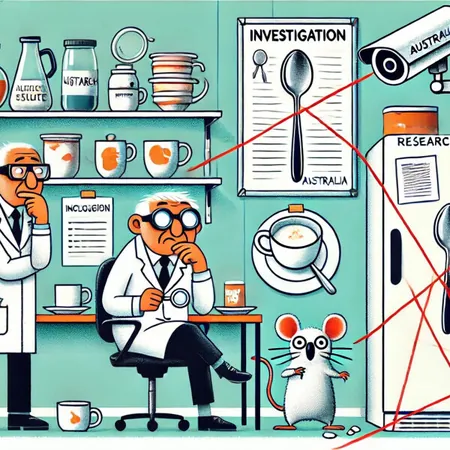
The Disappearing Teaspoons: A 20-Year Study That Unveils Workplace Mysteries
2025-03-31
Author: Wei
Introduction
In a delightful twist on workplace phenomena, a study that first hit newsstands in 2005 continues to capture attention for its unique take on a common conundrum: the mysterious disappearance of teaspoons. This investigation, conducted by a team at the Macfarlane Burnet Institute for Medical Research and Public Health in Melbourne, Australia, stands out for its humorous premise and rigorous methodology, making it a classic in both scientific inquiry and office lore.
Research Methodology
The research, published in The BMJ’s holiday issue, aimed to quantitatively assess the loss of teaspoons within a bustling research institution. Researchers discreetly labeled and distributed 70 teaspoons—54 standard and 16 high-quality—across various kitchens and tearooms in the institute. What began as a frustration over vanishing utensils quickly transformed into a longitudinal study, engaging scientists in a playful yet methodical approach to data collection.
Findings
Over five months, weekly audits were conducted, revealing a shocking disappearance rate: 80% of the teaspoons vanished without a trace. This led to the conclusion that the average 'half-life' of a teaspoon in such communal settings was a mere 81 days—an eye-opening statistic that highlights the challenges offices face in maintaining communal resources.
Understanding Longitudinal Studies
The study not only provided insights into spoon attrition but also served as a model for longitudinal research—an observational design where subjects (in this case, teaspoons) are monitored over time to identify patterns and relationships. The researchers documented the time it took for each teaspoon to go missing, shedding light on social behaviors related to communal item usage.
Observations and Implications
Their findings suggested that shared environments, such as communal tearooms, accelerated the disappearance of teaspoons, with a fast half-life of just 42 days compared to 77 days in departmental-only spaces. Interestingly, the perceived value of a teaspoon did not significantly influence the loss rate. However, it raised questions about human behavior, including whether the prestige associated with higher-quality utensils attracted opportunistic use.
Lessons Beyond Tableware
The implications of the study extend beyond mere cutlery. The researchers pointed out that the quality of communal resources can significantly impact office culture and employee morale. Teaspoons play a small yet symbolic role in workplace dynamics, and their absence can lead to frustration, affecting overall job satisfaction.
Global Reactions
The captivating study drew a global response, with many sharing similar anecdotes about utensil loss in various professional environments. For instance, reports from a French hospital indicated that over 1,800 teaspoons had vanished in a similar timeframe, supporting the notion that this phenomenon transcends borders.
Continued Relevance of the Teaspoon Study
Fast forward to today, the Disappearing Teaspoons study remains a cherished part of scientific humor, applying playful observation to everyday experiences. Over the years, it has not only prompted discussions around workplace resources but also sparked insights into human behavior in shared spaces.
Conclusion
As the study approaches its 20th anniversary, it continues to resonate within academic circles and popular culture. The humorous speculation on possible 'teaspoon migration' or the practice of 'spoon-napping' has become a light-hearted way to discuss serious issues within workplace culture, shaping conversations on the management of shared resources. In the end, this quirky study encourages us to consider that the challenges of communal living—whether in an office or beyond—require ongoing vigilance and creativity to sustain a harmonious environment. After all, losing a teaspoon may be innocuous, but it reflects deeper threads of human behavior and communal dynamics that bind us together—or occasionally pull us apart.
 Brasil (PT)
Brasil (PT)
 Canada (EN)
Canada (EN)
 Chile (ES)
Chile (ES)
 Česko (CS)
Česko (CS)
 대한민국 (KO)
대한민국 (KO)
 España (ES)
España (ES)
 France (FR)
France (FR)
 Hong Kong (EN)
Hong Kong (EN)
 Italia (IT)
Italia (IT)
 日本 (JA)
日本 (JA)
 Magyarország (HU)
Magyarország (HU)
 Norge (NO)
Norge (NO)
 Polska (PL)
Polska (PL)
 Schweiz (DE)
Schweiz (DE)
 Singapore (EN)
Singapore (EN)
 Sverige (SV)
Sverige (SV)
 Suomi (FI)
Suomi (FI)
 Türkiye (TR)
Türkiye (TR)
 الإمارات العربية المتحدة (AR)
الإمارات العربية المتحدة (AR)